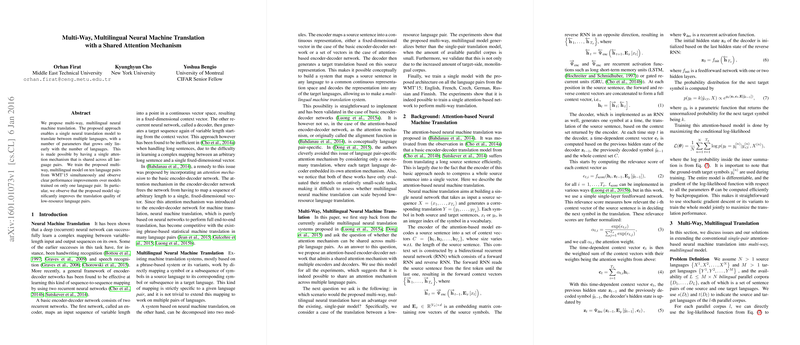Multi-Way, Multilingual Neural Machine Translation with a Shared Attention Mechanism
The paper presents a methodological advancement in neural machine translation (NMT) by introducing a multi-way, multilingual model with a unified attention mechanism. This approach contrasts the traditional setup where translation models are typically designed for specific language pairs. The authors argue and demonstrate through empirical evidence that a single NMT model can handle translations across multiple languages, more efficiently utilizing computational resources while improving translation quality, especially for low-resource languages.
Core Contribution and Approach
The central contribution of this work is the shared attention mechanism integrated into an encoder-decoder architecture. Traditional models often suffer from inefficiencies when scaling up to multiple languages due to the proliferation of parameters with each additional language pair. The shared attention mechanism introduced here mitigates this problem by allowing parameter growth that is only linear with respect to the number of languages involved. This model is subsequently trained on ten language pairs from the WMT'15 dataset, showcasing improved translation accuracy compared to models optimized for single language pairs.
Technical Details
The proposed architecture features multiple encoders and decoders, each specific to a language, while relying on a shared attention mechanism. The encoder translates input sentences into a continuous representation that the decoder uses for generating the translated output. The shared attention mechanism effectively manages language pair-specific alignments, a notable challenge overcome by this architecture. The attention mechanism adjusts the contribution of each context vector based on its relevance, calculated using a shared single-layer feedforward network.
Results and Analysis
Experiments detailed in the paper reveal significant translation quality improvements for low-resource language pairs. The shared multilingual model consistently outperforms single-pair models. When applied to large-scale translation tasks, the model either matches or surpasses the performance of separate paired models in most cases, particularly excelling in translations targeting English. The BLEU score metrics confirm the model's adeptness in a multilingual setup.
Implications and Future Directions
This research has profound implications for the field of machine translation and AI research in linguistic applications. By efficiently managing computational resources and data, this method can potentially democratize access to high-quality translation models for languages with limited resources. The theoretical foundation laid by the shared attention mechanism suggests the viability of more generalizable encoder-decoder architectures that can be adapted to other sequence-to-sequence tasks beyond translation.
Future work might explore extending this framework to include unsupervised translation between language pairs absent from the training data. Additionally, the integration of advanced LLMing techniques and ensembling strategies could further enhance the performance of such multilingual systems. As AI and machine translation continue to evolve, approaches like the one this paper explores may lead to more universal and flexible computational linguistic tools, supporting a diverse array of global languages.
